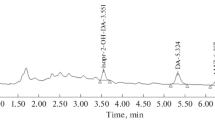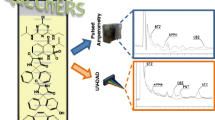Abstract
High-performance liquid chromatographic (HPLC) methods have been developed for the detection of uniconazole-P [(E)-1-(4-chlorophenyl)-4,4,-dimethyl-2-(1,2,4-triazol-1-yl)-1-penten-3-ol; XE-1019; the active ingredient in Prunit and Sumagic] in soil and plant tissue samples. Methanolic extracts of soil and plant samples were dried to the aqueous phase, the pH adjusted to 11, and partitioned against methylene chloride. The methylene chloride phases were washed with pH 11 water and then passed through C-18 solid phase extraction (SPE) columns. The soil extracts were then dried and the residues taken up in 1 ml acetonitrile of which 20 μl were injected directly onto a C-18 reverse phase analytical column for HPLC analysis. Plant tissue extracts were purified by partitioning and passing through a sequence of Florisil/C-18/Florisil SPE columns before HPLC analysis. Recovery of uniconazole-P was ∼70% from soils and ∼40% from plant tissues. Quantitative detection of 10 parts per billion (ppb) uniconazole-P in plant tissues and soil samples was feasible following these procedures. The soil cleanup procedures were also used to detect uniconazole-P in leachates collected from container-grown plants.
Similar content being viewed by others
References
Huntington GL, Wardlaw JC, Minno M, Allardice W, Monti C, and Shen A (1981) Soil Survey of the University of California, Davis (Campus and adjacent lands). Department of Land, Air and Water Resources, University of California, Davis, CA 95616
Izumi K, Yamaguchi I, Wada A, Oshio H, Takahashi N (1984) Effects of a new plant growth retardant, (E)-1-(4,4-dimethyl-2(1,2,4-triazol-1-yl)-1-penten-3-ol (S-3307), on the growth and gibberellin content of rice plants. Plant Cell Physiol 25:611–617
Knox GW, Norcini JG (1987) Effects of XE-1019 and pruning onPyracantha koidzumi “Wonderberry,”Photinia × fraseri, andLigustrum × ibolium. The Woody Ornamentalist 12:1–5
Sachs RM, Campidonica MJ, Booth M (1989) Chemical control of tree growth by bark paints. Symposium on Chemical Vegetation Management. Plant Growth Regulator Society of America. 15th Annual Meeting, San Antonio, TX, August 1–4, 1988 (in press)
Stahly EA, Buchanan DA (1986) Extraction, purification, and quantitation of paclobutrazol from fruit tree tissues. HortScience 21:534–535
Steffens GL (1988) Gibberellin biosynthesis inhibitors: comparing growth-retarding effectiveness on apple. J Plant Growth Regul 7:27–36
Sterrett JP (1988) XE-1019: Plant response, translocation and metabolism. J Plant Growth Regul 7:19–27
Valent Corporation. Third Annual Tree Growth Regulator Symposium. San Diego, CA, March 1–3, 1988. Sponsored by the Valent Corporation, a subsidiary of Chevron CorporationA0443016 00006 CS-SPJRNPDF [HEADSUP]
Author information
Authors and Affiliations
Rights and permissions
About this article
Cite this article
Booth, M.C., Campidonica, M.J., Fujino, D.W. et al. HPLC methods for detection of uniconazole-P in soils and plant tissues. J Plant Growth Regul 8, 293–300 (1989). https://doi.org/10.1007/BF02021822
Received:
Accepted:
Issue Date:
DOI: https://doi.org/10.1007/BF02021822




